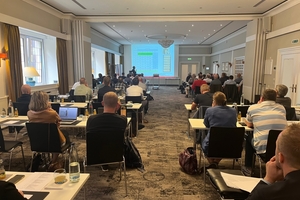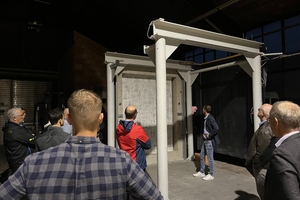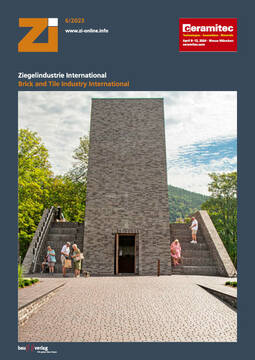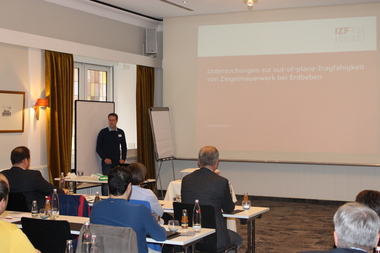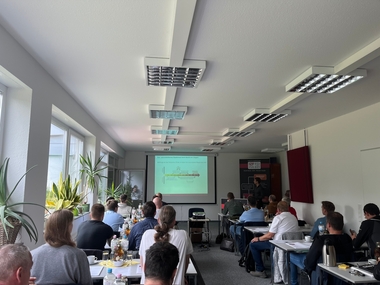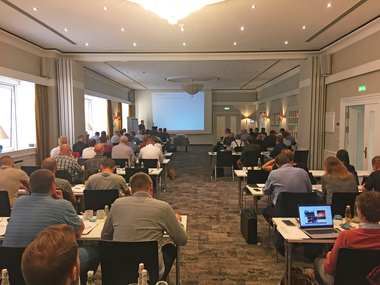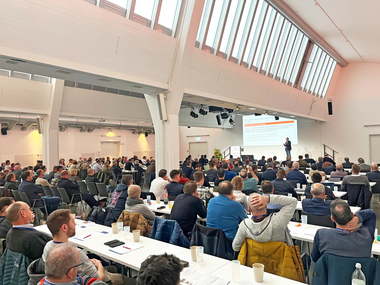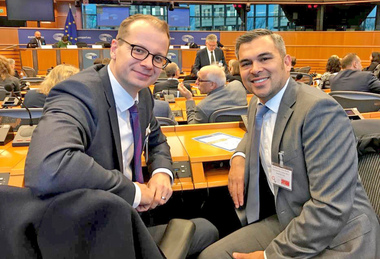IZF Seminar 2023: Brick production and application
The traditional IZF seminar took place again this year at the Institute for Brick and Tile Research in Essen e. V. (IZF). Around 50 experts from the brick and tile industry and their suppliers took part in the event on 19 and 20 September 2023, which this time was entitled „Brick production and application“. As in previous years, the conference venue was the Hotel Essener Hof.
Presentations on the first day
The deputy director of the institute, Eckhard Rimpel, welcomed the participants in the first speech of the first day. When describing this year‘s semi-themes, he spoke of a déjà vu. This can be explained simply by the fact that the topics of energy efficiency, raw materials, additive process engineering and building physics remain just as relevant. Rimpel warmly welcomed Heiner Kruse, M. Sc., from the Rhineland-Palatinate Technical University of Kaiserslautern-Landau as a guest, who would be presenting a project carried out jointly with the IZF.
In the first lecture of the seminar, „Overview of funding opportunities for energy and resource efficiency“, Marzieh Nourbakhsh presented the „Federal funding for energy and resource efficiency in the economy - grants and loans“ from the Federal Office of Economics and Export Control and the climate protection contracts from the Federal Ministry of Economics and Climate Protection.
The second presentation focussed on new rules and conditions in emissions trading. Eckhard Rimpel discussed the update of the amended Renewable Energy Directive (RED III), regulations on the use of coal, the interaction of the EU Emissions Trading System (EU ETS) with the national emissions trading system (nEHS) and the Best Available Techniques Reference Document (BREF).
Dr Rigo Giese then presented the results of the H2-Brick research project under the title „H2-Ziegel: Hydrogen as fuel“. Clinker bricks, roof tiles and vertically perforated bricks were tested. The evaluation showed that hydrogen posed no or no serious problems in terms of firing technology and product. The real hurdle is the economic provision of green hydrogen. (See also the report on the H2-Ziegel project by project participant Hagemeister GmbH on p. 40).
In a second presentation, Giese discussed the obvious question of the use of ammonia as a fuel. A research project is currently underway in co-operation with the Gas and Heat Institute in Essen. In contrast to hydrogen, ammonia is easier to transport and store. However, there is a great need for clarification before its use in the brick and tile industry is possible, for example concerning the formation of nitrogen oxide emissions, unstable ignition and combustion as well as the influence on product qualities.
After the lunch break, Denny Matthew Alex presented a tunnel kiln process model and discussed its intended use and simulation results. The model presented depicts the temperature profile of roof tiles along the tunnel kiln and the processes taking place in it. In his presentation, Alex explained the modelling and simplification steps involved in developing the model. Using several examples, he illustrated the possible applications and findings of numerical simulation, e.g. how the energy requirement is reduced at a higher combustion air temperature and what influence the roof tile configuration has on the mass flow rates.
The third presentation by Dr Rigo Giese dealt with „Electrification of existing tunnel kilns - solutions and challenges“. The challenge in an electric furnace is that the main heat transfer components, convection through the burner and radiation from the combustion gas, are no longer present. He discussed the current temperature limits of circulators and hot air generators, research directions for their optimisation and the use of heating elements. However, the availability of green electricity is crucial for reducing CO2 emissions. Using the current electricity mix produces more CO2 than using a mixture of natural gas and hydrogen.
Marius Rimpel presented the results of the HoTempLa research project. A new transport system based on high-temperature bearings enables more energy-efficient firing of brick products in the tunnel kiln. Internal high-temperature bearings reduce the exit loss via the tunnel kiln car. Rimpel explained the silicon nitride material used, the development steps towards a mechanical model and the test results.
Alexander Winkel explored the influence of the drying atmosphere and sample geometry for low-energy drying in his presentation. Based on the results of drying tests of various bricks under different temperatures, relative humidities and flow velocities, he showed that predictable drying with ambient air is possible.
Winkel also gave the follow-up lecture „Reconstruction of a Roman floor for the Xanten Archaeological Park“. He explained the three work steps, namely analysing the tile, the binder and the ratio of binder to tile, and presented the results. He also addressed the problems involved in reconstruction, including the following: Which screed is the right one? How exactly can and should the original state be restored in view of better raw materials and processes?
To round off the first day, Eckhard Rimpel spoke about the use of additives to reduce energy requirements. In view of the increases in energy efficiency already achieved, a reduction in CO2 and other pollutant emissions is only possible for the time being by changing the operating mixture. Rimpel presented test results with various additives. At a reduced firing temperature, these ensured the same strength in the product and a reduction in process-related emissions.
Afterwards, many of the participants went to the traditional drinks reception on the institute‘s premises in Essen-Kray. A marquee in the courtyard offered a defence against the uninviting weather and a rich buffet against hunger. As in previous years, the institute staff guided interested visitors through the workshops and presented and explained the test stands and set-ups.
Presentations on the second day
Heiner Kruse introduced the programme for the second day with his lecture „Fire resistance in partially loaded components“. The aim of the project, which he described, is to expand the possible applications of monolithic, thermally insulating brickwork. To this end, there is a lack of knowledge about how modern, thermally insulating vertically perforated bricks behave under single and double eccentric loading in the event of fire. He described the project, the tests and the initial results of the ongoing project.
Akash Nagaraj then spoke about measures to improve the urban climate. The corresponding project focussed on the question of what influence building materials have on the formation of heat islands in urban areas. Nagaraj described in detail the parametric study carried out for this purpose using the ENVIMET software. This revealed a clear dependence of the air temperature on the reflectance of the building material.
Mislina Tavli presented material and component analyses using optical measurement technology in his lecture. In addition to a general introduction to the method of optical measurement, he presented various 3D measurement systems and demonstrated how they work and how they are used on the basis of several tests carried out: for example, to record the effect in simulations of earthquake loads, in fire pressure tests, tests on the compressive strength of bricks, 3-point bending tests or the measurement of deformations during drying.
Tavli also gave the next lecture and spoke about sound measurement and room acoustics. He began by explaining the physical, legal and conceptual principles of sound insulation and soundproofing. He then explained DIN 4109 and the sound insulation verification standards DIN EN ISO 16283-1 and DIN EN ISO 16283-2 and went into detail on methods and instruments for impact, air and façade sound insulation.
After the coffee break, Alexander Winkel reported on the use of brick-rich crushed sand in Portland pozzolanic cements. He discussed the origin of brick-rich demolition material and that masonry rubble can be characterised by means of colour measurement. He discussed the use of brick flour in Portland cement based on the results of two research projects, including the energy required for grinding masonry and the fact that there is a correlation between the colour of the crushed sand and its brick content, but not its pozzolanic activity.
Eckhard Rimpel, deputising for Sandra Petereit, then provided information on recycling routes for bricks through targeted sorting. He presented the applicable legal requirements in Europe and Germany, followed by examples. Two of these were recycling in the form of reprocessing old bricks and research into the sorting of demolition waste and broken bricks, for example the IZF project „Intelligent sorting of masonry with the help of machine learning models“.
Alexander Winkel focussed on the influence of organics on the firing curve in the last lecture of the IZF seminar. During brick firing, exothermic reactions take place in the brick due to the presence of organics. Winkel discussed this based on the results of simultaneous thermal analyses of various organic additives and the formation of black cores in bricks. The reason for this is black magnetite, which forms when carbon is insufficiently oxidised. As a solution, he suggested a longer oven time above 650 degrees Celsius in an oxidising atmosphere.
In his concise and cordial closing remarks, Eckhard Rimpel thanked those present for their perseverance and announced that the next IZF seminar would take place in Essen on the same or a near date. The traditional joint lunch brought the event to a close.

